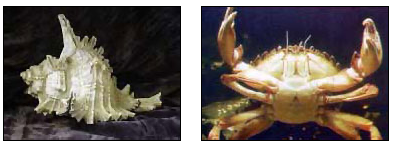Predator/prey coevolution can lead to an evolutionary arms race.
Consider a system of plant-eating insects. Any plant that happens to evolve a chemical that is repellent or harmful to insects will be favored. But the spread of this gene will put pressure on the insect population — and any insect that happens to have the ability to overcome this defense will be favored. This, in turn, puts pressure on the plant population, and any plant that evolves a stronger chemical defense will be favored. This, in turn, puts more pressure on the insect population…and so on. The levels of defense and counter-defense will continue to escalate, without either side “winning.” Hence, it is called an arms race. This sort of evolutionary arms race is probably relatively common for many plant/herbivore systems.
Other predator/prey systems have also engaged in arms races. For example, many molluscs, such as Murex snails, have evolved thick shells and spines to avoid being eaten by animals such as crabs and fish. These predators have, in turn, evolved powerful claws and jaws that compensate for the snails’ thick shells and spines.

